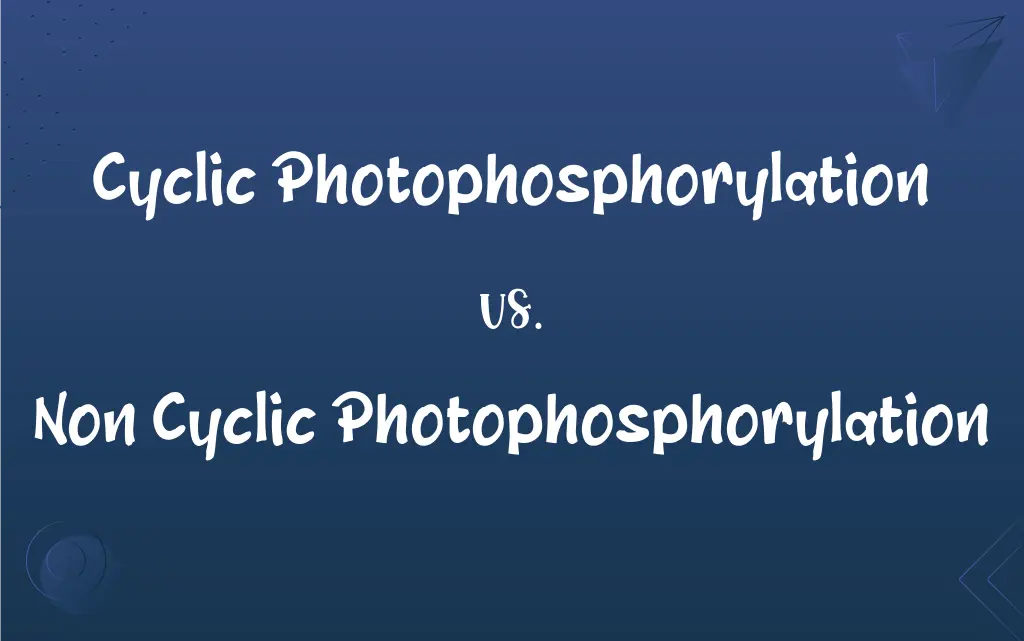Cyclic Photophosphorylation vs. Non Cyclic Photophosphorylation: What's the Difference?
Edited by Aimie Carlson || By Harlon Moss || Updated on October 30, 2023
Cyclic photophosphorylation involves only photosystem I, producing ATP without oxygen, while non-cyclic photophosphorylation involves both photosystems I and II, producing ATP, oxygen, and NADPH.

Key Differences
In cyclic photophosphorylation, electrons from the chlorophyll molecule are excited by light energy and are passed through a series of carriers before returning to the chlorophyll. This process pumps protons across the thylakoid membrane, creating a proton gradient used by ATP synthase to generate ATP. Non-cyclic photophosphorylation also involves the excitation of electrons in chlorophyll, but these electrons are not returned to the chlorophyll molecule. Instead, they are used to reduce NADP+ to NADPH, and water molecules are split to replace the electrons and produce oxygen.
The primary purpose of cyclic photophosphorylation is to produce additional ATP needed for the dark reactions of photosynthesis, while non-cyclic photophosphorylation is the main method by which energy is harvested from sunlight and used to produce the ATP and NADPH necessary for the synthesis of glucose from carbon dioxide. This distinction highlights the interdependence of the two processes in the overall mechanism of photosynthesis.
In summary, cyclic photophosphorylation is a method by which plants and other photosynthetic organisms generate ATP without producing oxygen or NADPH, while non-cyclic photophosphorylation is the main way in which light energy is converted into chemical energy in the form of ATP, NADPH, and oxygen. The differences between the two processes illustrate the complexity and efficiency of the photosynthetic machinery.
Comparison Chart
Photosystems Involved
Only Photosystem I
Photosystem I and II
Oxygen Production
Does not produce oxygen
Produces oxygen as a byproduct
ADVERTISEMENT
End Product
Only ATP
ATP, NADPH, and oxygen
Electron Source and Destination
Electrons return to chlorophyll
Electrons do not return to chlorophyll
Role in Photosynthesis
Generates additional ATP for dark reactions
Main method of harvesting energy from sunlight
Cyclic Photophosphorylation and Non Cyclic Photophosphorylation Definitions
Cyclic Photophosphorylation
Cyclic photophosphorylation is a process by which ATP is formed using light energy.
Cyclic photophosphorylation is essential for plants to generate the extra ATP needed for the Calvin cycle.
Non Cyclic Photophosphorylation
Non-cyclic photophosphorylation is a process by which ATP, NADPH, and oxygen are formed using light energy.
Non-cyclic photophosphorylation is crucial for the production of glucose in plants.
ADVERTISEMENT
Cyclic Photophosphorylation
Cyclic photophosphorylation creates a proton gradient across the thylakoid membrane.
The proton gradient formed during cyclic photophosphorylation drives the synthesis of ATP.
Non Cyclic Photophosphorylation
Non-cyclic photophosphorylation involves both photosystem I and II.
The involvement of both photosystems allows non-cyclic photophosphorylation to produce more energy than cyclic photophosphorylation.
Cyclic Photophosphorylation
Cyclic photophosphorylation is used to generate additional ATP for the dark reactions of photosynthesis.
Cyclic photophosphorylation provides the energy necessary for synthesizing glucose from carbon dioxide.
Non Cyclic Photophosphorylation
Non-cyclic photophosphorylation produces oxygen as a byproduct.
The oxygen produced during non-cyclic photophosphorylation is released into the atmosphere.
Cyclic Photophosphorylation
Cyclic photophosphorylation involves only photosystem I.
Unlike non-cyclic photophosphorylation, cyclic photophosphorylation does not produce NADPH.
Non Cyclic Photophosphorylation
Non-cyclic photophosphorylation results in the reduction of NADP+ to NADPH.
The NADPH produced in non-cyclic photophosphorylation is used in the synthesis of glucose.
Cyclic Photophosphorylation
Cyclic photophosphorylation does not produce oxygen as a byproduct.
Plants use cyclic photophosphorylation to generate ATP without releasing oxygen.
Non Cyclic Photophosphorylation
Non-cyclic photophosphorylation is the main method by which light energy is harvested and converted into chemical energy.
Non-cyclic photophosphorylation is integral to the process of photosynthesis.
FAQs
What photosystems are involved in cyclic photophosphorylation?
Only photosystem I is involved in cyclic photophosphorylation.
What is cyclic photophosphorylation?
A process where ATP is produced using light energy, involving only photosystem I, and not producing oxygen or NADPH.
Does cyclic photophosphorylation produce oxygen?
No, cyclic photophosphorylation does not produce oxygen.
Does non-cyclic photophosphorylation produce oxygen?
Yes, non-cyclic photophosphorylation produces oxygen as a byproduct.
What is the primary purpose of cyclic photophosphorylation?
To produce additional ATP needed for the dark reactions of photosynthesis.
Does cyclic photophosphorylation use water molecules?
No, cyclic photophosphorylation does not use water molecules.
What photosystems are involved in non-cyclic photophosphorylation?
Both photosystem I and II are involved in non-cyclic photophosphorylation.
Does non-cyclic photophosphorylation generate a proton gradient?
Yes, non-cyclic photophosphorylation also generates a proton gradient across the thylakoid membrane.
Does non-cyclic photophosphorylation use water molecules?
Yes, non-cyclic photophosphorylation uses water molecules, which are split to replace the electrons.
What is non-cyclic photophosphorylation?
A process that produces ATP, NADPH, and oxygen by using light energy, involving photosystems I and II.
Does non-cyclic photophosphorylation involve the reduction of NADP+ to NADPH?
Yes, non-cyclic photophosphorylation involves the reduction of NADP+ to NADPH.
Where does the electron go in non-cyclic photophosphorylation?
The electron is used to reduce NADP+ to NADPH in non-cyclic photophosphorylation.
Does cyclic photophosphorylation produce ATP?
Yes, cyclic photophosphorylation produces ATP.
Does non-cyclic photophosphorylation produce ATP?
Yes, non-cyclic photophosphorylation produces ATP.
Is cyclic photophosphorylation essential for photosynthesis?
Cyclic photophosphorylation is not essential but helps in generating additional ATP for photosynthesis.
Is non-cyclic photophosphorylation essential for photosynthesis?
Yes, non-cyclic photophosphorylation is essential for photosynthesis as it produces the ATP, NADPH, and oxygen needed for the synthesis of glucose.
What is the primary purpose of non-cyclic photophosphorylation?
To harvest energy from sunlight and convert it into ATP, NADPH, and oxygen.
Does cyclic photophosphorylation involve the reduction of NADP+ to NADPH?
No, cyclic photophosphorylation does not involve the reduction of NADP+ to NADPH.
Does cyclic photophosphorylation generate a proton gradient?
Yes, cyclic photophosphorylation generates a proton gradient across the thylakoid membrane.
Where does the electron return in cyclic photophosphorylation?
The electron returns to the chlorophyll molecule in cyclic photophosphorylation.
About Author
Written by
Harlon MossHarlon is a seasoned quality moderator and accomplished content writer for Difference Wiki. An alumnus of the prestigious University of California, he earned his degree in Computer Science. Leveraging his academic background, Harlon brings a meticulous and informed perspective to his work, ensuring content accuracy and excellence.
Edited by
Aimie CarlsonAimie Carlson, holding a master's degree in English literature, is a fervent English language enthusiast. She lends her writing talents to Difference Wiki, a prominent website that specializes in comparisons, offering readers insightful analyses that both captivate and inform.































































